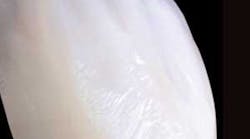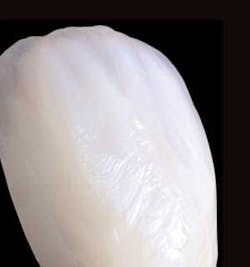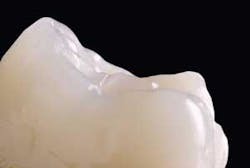Pressed ceramic vs. feldspathic veneers
By Christopher Pescatore, DMD
Cosmetic dentistry is rapidly moving beyond the realm of celebrities. More and more consumers believe emulating a superstar smile is the key ingredient to social and professional success. Thanks to cosmetic dentistry, particularly veneers, these people can attain the smile of their dreams.
Ceramic porcelain veneers give people a healthy, natural-looking smile. Dentists often recommend them to enhance esthetics, restore tooth structure and function, and correct some orthodontic problems. During the last 20 years, tremendous innovation and improvement in veneer technology has led to greater predictability and success rates, as well as lower costs. This combination of quality and low cost has fueled consumer interest.
For many years, ceramic veneers were fabricated with porcelain layers painted on to build up structure. This created a feldspathic porcelain veneer, which was the only veneer available until 15 years ago, when some of the more advanced labs began a new fabrication technique. The new technique actually cured the veneers under heat and extreme pressure, and resulted in a different kind of porcelain - pressed ceramic, which is twice as strong and long lasting as the older, thinner feldspathic veneers.
Pressed ceramic veneers also allow for more subtle color nuances and luminosity, which make them more natural looking. One brand in particular, MicroDental’s MAC Veneers™, led the way and is currently the leading pressed ceramic brand on the market.
As veneers have evolved, others have emerged, such as the ultra-thin variety that claimed no prep was needed. However, these veneers have not caught on for many reasons - they do not last as long, they cannot effect dramatic color shifts, and they cannot change the shape of teeth. Dentists now must choose primarily between feldspathic and pressed ceramic veneers.
This leads to the question, “Which veneer works best?” Based on popular opinion, the clear choice is pressed ceramics. However, some dentists still use feldspathic systems almost exclusively, and others prefer them in certain situations. While I’m sure there are many reasons, I suspect that some dentists are traditionalists used to working with feldspathic veneers who simply haven’t educated themselves about pressed ceramics. But up-to-date dentists select different systems in different situations because they’ve done their homework, and have reasons for each choice. This article addresses some of those reasons.
Fabrication
Feldspathic veneers are created the same way today as they were 20 years ago. They are fabricated from quartz type porcelain on a platinum foil or refractory die. Ceramicists use a wet brush and jar of porcelain powder to paint layers onto a model and then bake it in a porcelain oven. Since each application of porcelain is very thin and shrinks when heated, the process is repeated many times to obtain the proper contour. Ceramicists can lay in different colors at each stage to create the desired look.
Pressed ceramic veneers are made much differently. They are fabricated by waxing a tooth to the desired contour, investing it, and melting out the wax. They are then injected with a lucite-based molten porcelain and given constant hydraulic pressure to press in additional material as the porcelain cools and shrinks, hence the name pressed ceramic. The process is similar to fabricating gold, and results in a porcelain ingot that fills out the desired contour in a single color. Ceramicists can then create more natural, less-uniform coloration by cutting back the ingot and painting customized colored porcelains in various areas of the tooth. The cut-back procedure reverses the gradual build-up method associated with feldspathic fabrication.
Point-by-point breakdown
Pressed ceramics come out ahead in these areas commonly used to evaluate veneers:
Strength - Pressed ceramic porcelains are at least two times stronger than feldspathic. This is because the material is cast under heat and constant pressure, which increases the tightness of the particles and makes the material much denser. Consequently, pressed ceramic restorations are far more durable and resistant to fracture.
Versatility - The inherent strength of pressed ceramic porcelain supports a much larger range of treatments and restorations than feldspathic material. For example, dentists can use it in bridges without a metal substructure. Whereas feldspathic porcelain usually requires a metal substructure for back-of-the-mouth restorations, dentists can use pressed ceramic material in full-mouth reconstruction without any metal. Since it is much harder to match porcelain-fused-to-metal crowns with feldspathic veneers, the all-ceramic option allows dentists to create a more natural looking uniformity of optical properties among the teeth. Today’s patients are more informed and frequently ask for metal-free restorations; pressed ceramic systems allow dentists to provide these for the entire mouth.
Wearability - Pressed ceramic porcelain is less abrasive to opposing teeth than feldspathic porcelain. Numerous studies show that feldspathic material is far more aggressive against natural dentition and causes significantly greater wear and damage. Pressed ceramic porcelain is much closer in abrasiveness to natural tooth enamel.
Fit - Pressed ceramic veneers generally fit better than feldspathic. When fabricating a feldspathic veneer, the technician repeatedly adds layers and fires them in the oven, which causes the porcelain to shrink and warp. On the other hand, pressed ceramic veneers are waxed to ideal at the beginning and then cast, so it is easier to obtain a much tighter marginal integrity and fit. With a better fit, bonding requires less resin luting cement and a minimal cement thickness. This makes restorations stronger.
Predictability of results - Technicians trained in pressed ceramic waxing, casting, and cut-back techniques can apply their skills with consistent results. Comparatively, feldspathic methods are much less predictable and susceptible to human error. The results depend largely on the ceramicist’s artistic abilities and are usually less precise. In either case, it is important that dentists choose a laboratory with highly qualified technicians. MicroDental’s experienced technicians specialize in veneers and work on more restorations than individual dentists, so they understand how teeth should be prepared to achieve a certain look.
Feldspathic arguments
With all of the advantages of pressed ceramic restorations, one has to wonder why anyone would use feldspathic veneers. The most common argument for feldspathic veneers is that they require dentists to remove less tooth structure. While this is true, the difference - .3 mm vs. .8 to 1.0 mm - is not as great as feldspathic proponents claim. Generally, skilled dentists need not remove more than .5 to .6 mm when prepping for pressed ceramic veneers.
Dental students learn to adhere to a conservative principle: remove only as much tooth structure as necessary. This is certainly sensible, but “necessary” is a relative term and is frequently determined by what will satisfy the patient, as long as that’s possible and does no harm. Patients usually want bright smiles with well-formed teeth that look real. They also want their expensive restorations to last for a reasonable time, ideally the rest of their lives. By these standards, .3 mm represents no critical limit. Overly cautious dentists who observe this limit can easily under-prep for feldspathic veneers. For example, if a dentist removes only .3 mm, then applies extra layers of porcelain to mask the yellow in existing teeth, the veneers may look bulky and artificial. But if the dentist anticipates this problem by removing more tooth structure, he or she might as well use pressed porcelain.
It’s not clear if saving a minimal amount of tooth structure ever justifies feldspathic veneers - especially since pressed is stronger, less abrasive, better fitting, more natural looking, and longer lasting.
Another common argument is that traditional layering allows artistic ceramicists to create veneers that are more natural than the finest pressed porcelains. This reason is due to the thinness of feldspathic material. Since the layers are very thin, ceramicists can allow what’s attractive in existing teeth to shine through, then mask flaws and enhance colors without creating a painted-on look. On the other hand, technicians who use pressed ceramics can’t exploit the natural appearance of an existing tooth. They must start with a fully contoured ingot in a uniform shade, then render the ingot more natural with cut-back techniques. Some dentists believe this disadvantage can’t be overcome, and recommend feldspathic veneers when natural beauty is the primary concern.
Here are three points about natural beauty that are contrary to the view of dentists who favor feldspathic veneers:
- Saying that the natural appearance of feldspathic porcelains can’t be matched by pressed ceramic veneers is questionable. Virtually any color or optical property that can be achieved through feldspathic layering can be mimicked by pressed ceramic cut-back methods. While ceramicists can’t use these techniques to exploit the actual color of existing teeth, they can match that color, if that’s what the dentist and patient want.
- Oftentimes, this isn’t what dentists and patients want. If traditional layering techniques exploit the color of existing teeth, the veneers will be darker than what most patients envision. Although they say they want natural smiles, they also want smiles that are whiter. They want teeth with the same range of gradations and optical properties, such as fluorescence, opalescence, opacity, and translucency, with more brightness and whiteness. Technicians can easily press a ceramic ingot in the middle of this range, and then use a spectrum of shades to create a customized and natural looking color.
- Finally, one should distinguish between the initial results of veneer placement, and what those results might look like in five years. A feldspathic placement lets the color of an existing tooth shine through, while the veneer is subject to shade shift over time. Human teeth change color as people age. The nerve canal in the center of a tooth shrinks, and the yellow and brown dentin fills in, darkening the tooth. If feldspathic veneers allow the existing tooth structure to shine through, the veneers will darken as well - so much so that patients may need to have them redone in as few as five years. Hence, the putative virtue of feldspathic veneers - their inherent translucency - turns into a vice over time. Pressed ceramics almost never change shade.
Based on these arguments it is obvious that pressed ceramic porcelain makes the best veneers. It consistently delivers beautiful, natural-looking smiles, which makes patients happy, and happy patients are a dentist’s best marketing tools.
Dr. Christopher Pescatore lectures worldwide on state-of-the-art esthetic procedures, techniques, and materials. A graduate of the University of Medicine and Dentistry of New Jersey-New Jersey Dental School, he holds a U.S. patent for a nonmetallic post system to restore endodontically treated teeth. Dr. Pescatore has a full-time practice in Danville, Calif., dedicated exclusively to esthetic dentistry. He can be reached via e-mail at [email protected].









